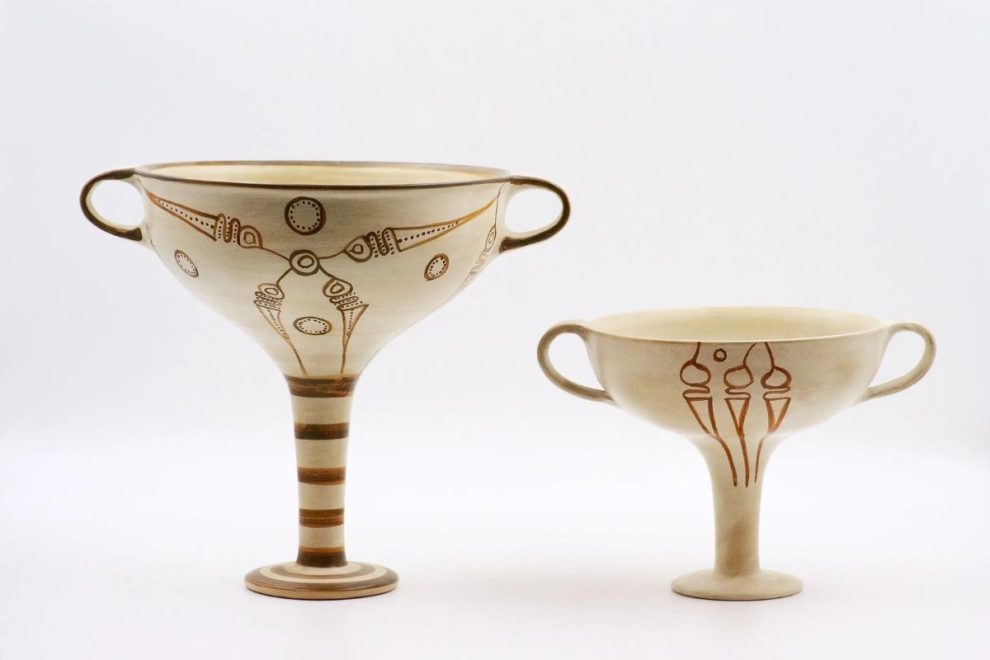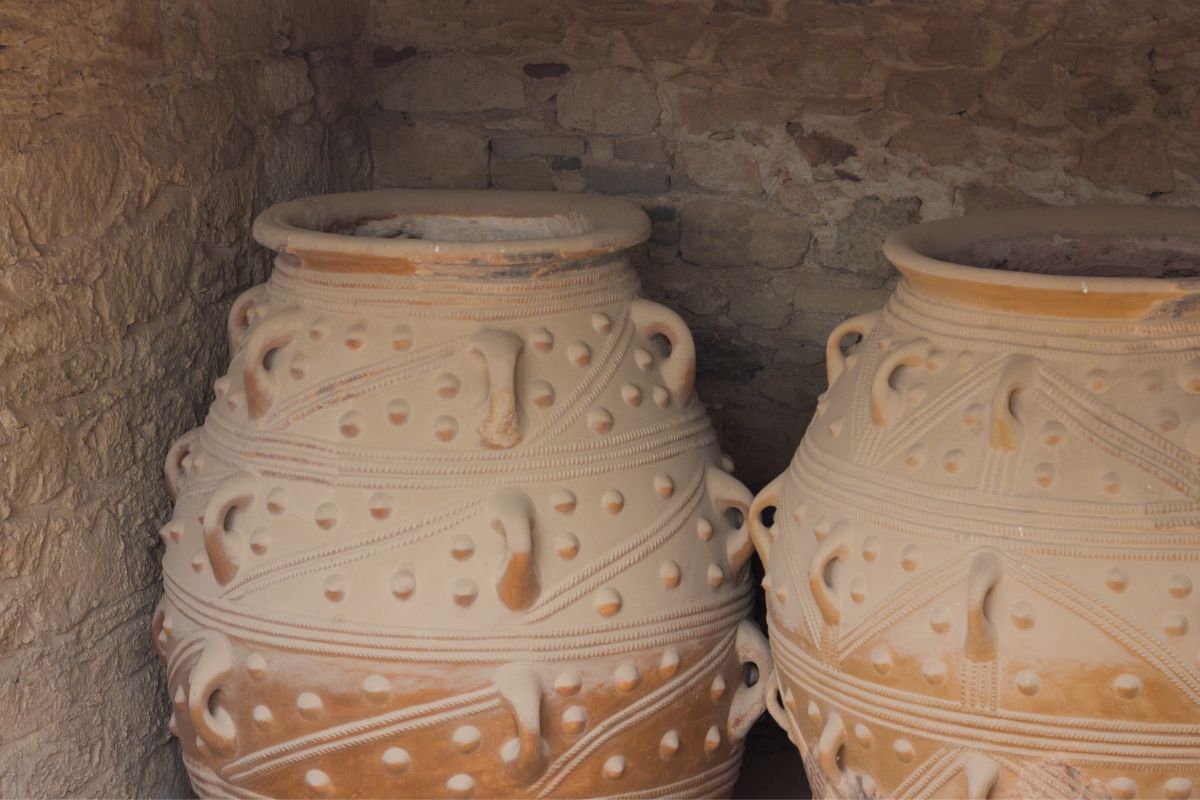
Minoan pottery reveals the artistry, beliefs, and daily life of Bronze Age Crete.
Key Highlights
Here is a quick look at what we will cover about Minoan pottery:
- Minoan pottery originated during the Bronze Age on the island of Crete.
- The evolution of pottery styles helps archaeologists date different historical periods.
- Famous styles include the polychrome Kamares ware and the nature-inspired Marine style.
- Minoan potters used the pottery wheel and advanced kilns to create their wares.
- Designs often featured sea creatures, plants, and sometimes religious symbols.
- Inscriptions in Linear B on some pottery give us clues about their contents.
The art made by people in the Minoan civilization in Crete is a way to see life in the Bronze Age. One more thing that stands out is their pottery. It is known for the look and skill in each item. The styles of Minoan pottery changed often. That shows the people in Minoan Crete liked new things and ways to make art. Looking at pottery production from the Minoan period helps us know about how they lived, what they believed, and the trading that brought many items in and out. This article will go through the story and meaning of these special ceramic pieces from the Minoan period.
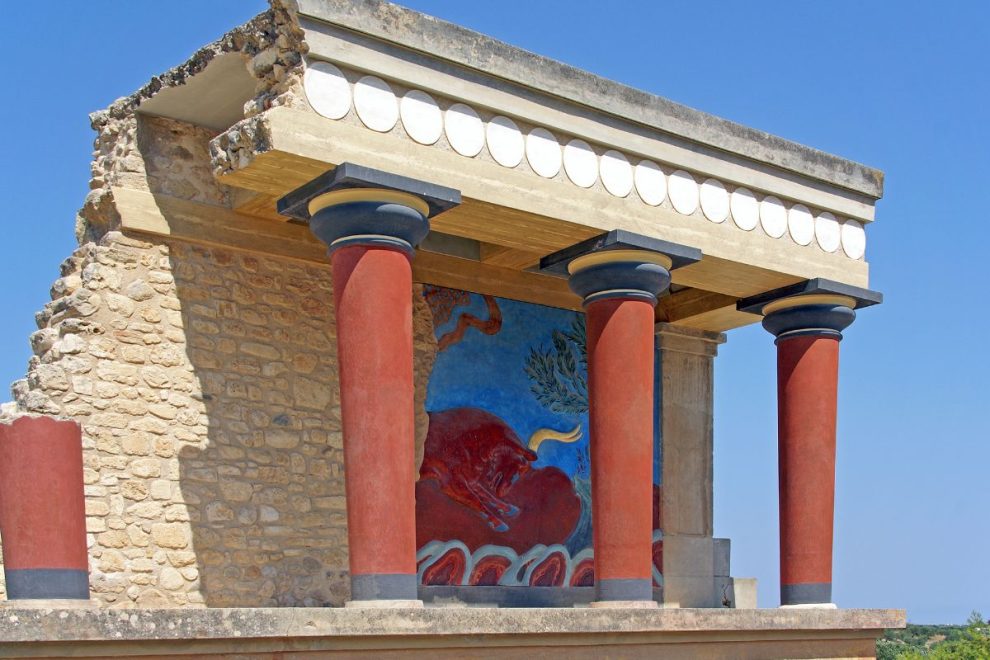
The Minoan Civilization Pottery Background
Pottery started in the early Minoan period and went on into the late Minoan period. Over time, the pottery changed in style and how people made it. They began using the pottery wheel. This made it easier to make vessels with thin walls, much like the innovation of the ancient pottery wheel that transformed Greek ceramics. People often decorated them with religious motifs, designs of marine life, and scenes from nature. Famous styles from the Minoan period are Kamares ware and Palace style, which influenced later designs such as Geometric Greek pottery. These show a lot about the art and ideas of that time. Now, many pieces from the early Minoan and late Minoan periods are in places like the Heraklion Archaeological Museum. These artifacts help us understand more of Minoan life and their skills.
Geography of Crete and Its Surroundings
The island of Crete was a good spot for a special culture to grow. It sits in the eastern Mediterranean, and that keeps it away from strong neighbors. Because of this, there was not much fighting. The people there could develop their way of life on their own. The Minoans did not often build cities with big walls. This shows there was peace and people felt safe.
The island of Crete is big and has lots of natural resources. There are plains that are good for farming. The Aegean Sea, all around the island, gave people food and helped with trade. These things made life better and helped the number of people grow on the island. As a result, the Minoan society did well during the Bronze Age.
People found Minoan pottery all over the island of Crete. They discovered it in palace sites in central Crete, and also at smaller settlement sites. Some pieces even came from cave places that were used as sanctuaries. These finds tell us that pottery production was common in many areas. The designs and styles changed from place to place on the island.
Early Archaeological Discoveries
People began to see Minoan pottery as something special in the late 1800s and early 1900s. At first, many of the pots found were called “Mycenaean” when seen on the Greek mainland. When they found these pieces in cave sanctuaries on Crete, experts started to know where the pottery came from. Now, the Heraklion Archaeological Museum has the largest group of this art for everyone to see.
There are many famous pieces. Some are big jars kept in Minoan palaces. Others are small cups or detailed bowls used for special reasons. The “Octopus Vase” is one of the best-known Minoan vases. It shows the marine style that Minoan artists liked, a creativity that inspired later works like the ancient Greek red figure pottery. Experts use different designs and shapes to classify and date Minoan pottery. Philip Betancourt said early Minoan pottery was very important for all of us.
Sir Arthur Evans started a way to sort these styles. It helps experts put dates on things found at both old and new layers of a site. This method is still one of the best ways to know Minoan history and their timeline.
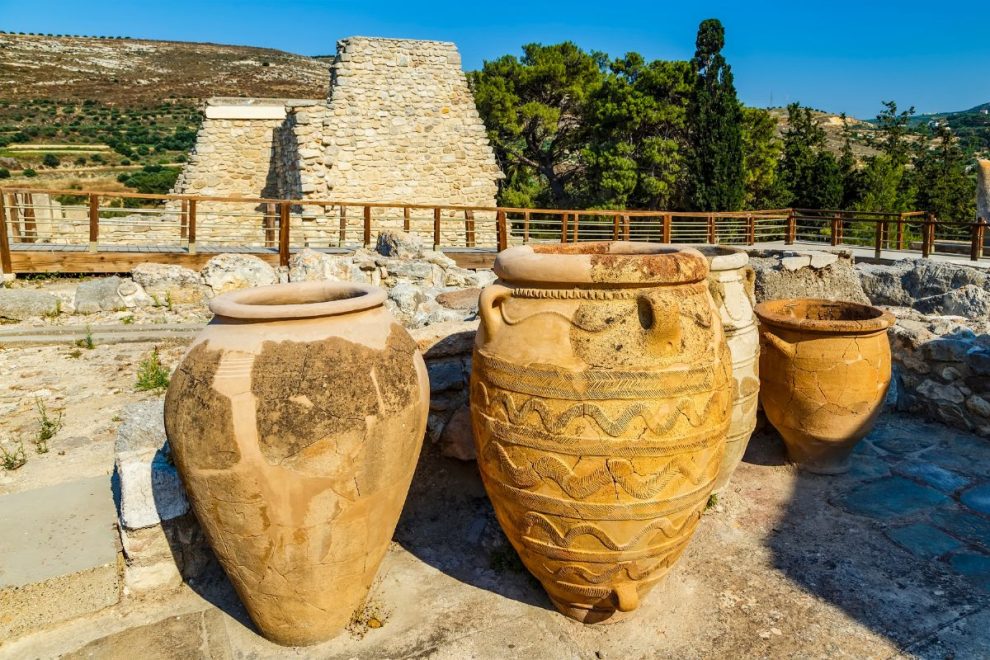
Minoan Pottery Periods
Archaeologists break the history of Minoan pottery into three main phases. The early Minoan period comes first, then the middle Minoan period, and finally the late Minoan period. Each of these brought big changes in how pots were made. The types and the way people decorated their pots changed during these times. These changes show what was happening in society and culture on Crete.
At first, people made pots by hand. They used simple designs. Later in the Middle Minoan period, they started using a potter’s wheel. The designs got more detailed and looked more like things you see in nature. Over time, forms and methods changed a lot during the Middle Minoan period and the Late Minoan period. Each stage shows how life and ideas grew on the island.
Next, you will see what makes each Minoan period special and what was different about pottery in every phase.
Early Minoan Period: 3000 – 2100 BCE
The Early Minoan period was the start of the Bronze Age on the island of Crete. This time shows that people kept some old Final Neolithic pottery styles, but they also made new types. Many places made pottery that looked different from each other. This tells us each group had its own local ways of doing things.
People back then made pottery by hand because the potter’s wheel was not in use on the island yet. The pottery is linked to other cultures living in the Aegean Sea, like those in the Cyclades. This means that the population on Crete came from many backgrounds, with some people coming in from the east and south.
Archaeologists group pottery from the early Minoan period by its shape, the way it is made, and how it is decorated. In the Bronze Age, they found many shiny pots with lines cut into them, and they also saw the first painted pottery. This way of sorting the pots helps experts follow how the special Minoan period art style grows and changes over time.
Middle Minoan Period: 2100 – 1600 BCE
The Middle Minoan period was a time when big Minoan palaces rose up at places like Knossos and Phaistos. The people in these centers needed a lot of pottery for daily life and for keeping things in storage. This meant the palace workshops made pottery in a more standard way. There was a big step forward during MM IB, when the introduction of the potter’s wheel made it possible to create pottery with shapes that were even and smooth.
The Middle Minoan period is well known for kamares ware. This kind of pottery uses many colors and gets its name from the cave where it was first found. The Minoan palaces made kamares ware, with high-quality pieces showing bold red and white designs on black. The patterns on the pottery are detailed, showing things like spirals, rosettes, and picture-like floral shapes.
You can see from the forms and ways pottery was made in the Middle Minoan period that this society liked new ideas and bringing out the best in art. The development of kamares ware at the different settlement sites is the high point of Minoan ceramic art. It shows the skill and creativity that the Minoan period is known for.
Late Minoan Period: 1600 – 100 BCE
During the Late Minoan period, Minoan culture was at its best. At this time, people liked new ways to decorate, and many designs showed a love for plants and flowers. The Floral Style became well-known. You could see things like lilies, papyrus, and leaves on the surfaces of vases.
The Marine Style, seen in Late Minoan IA, stood out even more. In this style, there were sea creatures like octopuses, dolphins, and starfish that looked like they moved around the pots. The patterns flowed all over the vases, making them full and lively. But during the late Minoan period, the Mycenaean Greeks came to Knossos. Soon, they took control.
When the Mycenaean Greeks arrived, they brought their own ideas. The pottery designs started to look more stylized and less like real things. The time when Minoan culture and the Mycenaeans mixed changed art for good. The Mycenaeans used many Minoan forms and the same kinds of designs, and this helped shape later Greek ceramic art on the mainland.
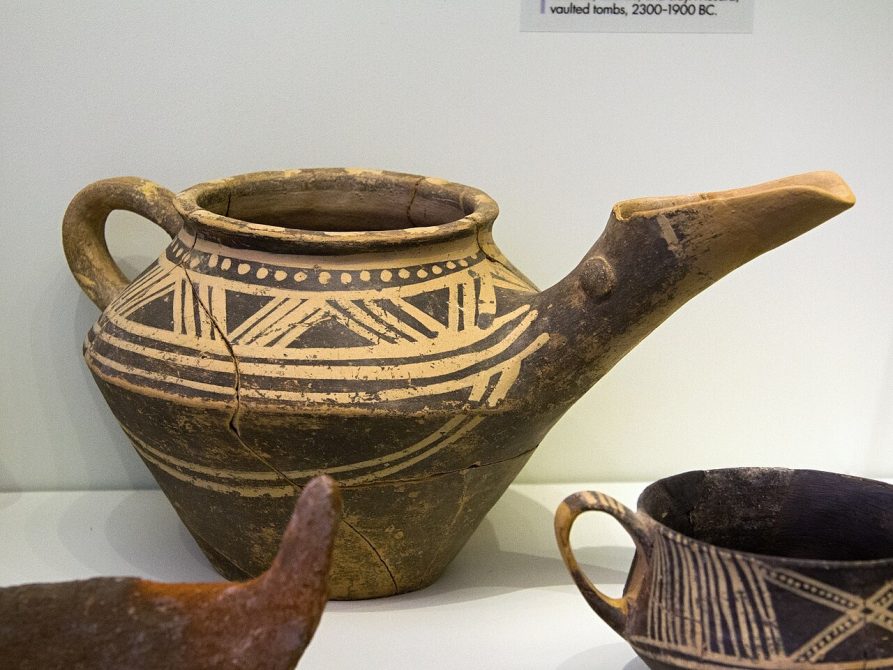
by: Zde
Chronology of Minoan Pottery Style
Archaeologists need to use the way Minoan pottery changes to help them make a timeline of the civilization. They watch for new shapes, designs, and how the pottery is made. This helps them put the artifacts in the right time and know which part of history they belong to. Every big period in Minoan history had its own main Minoan type of pottery.
This way of finding the age of things is called seriation. It matters a lot because there are not many old writings left by the Minoans that talk about what happened in history. The fact that pottery production keeps changing lets people see how the civilization moves from the start to the end, with an early period and then the late Minoan period. In the next parts, the specific styles that show the changes for each Late Minoan era will be discussed.
Early Minoan Pottery
The Early Minoan period was a time of great variety in pottery production. Styles often differed from one part of Crete to another, reflecting local traditions. Several key wares define this era, showing a gradual move from simple, dark-burnished surfaces to the first painted decorations. One of the most important was Vasiliki Ware, known for its mottled red and black surface achieved through controlled firing.
Another significant style was Agyios Onouphrios ware, which featured linear red patterns on a light background. This marked a major step in decorative technique for Minoan pottery. Tripod cooking pots also became common during this time, indicating changes in food preparation.
These early styles laid the groundwork for the more complex designs that would follow. The experimentation with slips, firing, and form during the Early Minoan period was a critical phase in the development of Minoan ceramic art.
| Style Name | Key Characteristics |
|---|---|
| Pyrgos Ware | Black, grey, or brown burnished surface, often with incised linear patterns. |
| Incised Ware | Hand-shaped, dark-burnished jugs and cups with incised lines in herring-bone or other patterns. |
| Agyios Onouphrios Ware | Light-colored clay with painted red parallel lines. Forms include jugs and bowls. |
| Vasiliki Ware | Mottled glaze effect, created by uneven firing to produce dark spots on a lighter surface. |
Middle Minoan Pottery
The middle Minoan period is known for the way new styles of pottery started to show up, thanks to what people made in big palatial workshops. When people brought in the pottery wheel around 1900 BCE, it helped them make thinner pots. These pots also came out much more even and nice-looking. When you add in better kilns, the potters could make some of the best pieces anyone has seen from the Minoan period.
The best-known type from the middle Minoan period is Kamares ware. You can spot this style because it uses many colors. The artists would paint white and red designs on top of a black background. You see a lot of spirals, plants, and rosettes in the decorations. Some of the most amazing pieces are called Eggshell ware. These were so thin their walls were no more than one millimeter. Barbotine ware came out during this time, too, and you could feel the knobs and raised lines because the clay was put right onto the surface.
Big pots called Pithoi played a big role in middle Minoan life. These huge jars were made by hand and kept in palaces. They served a similar role to the amphora Greek vase in later Greek society. People used them to store things like oil, wine, and grain. In this way, you see how pottery production was useful as well as beautiful during the Middle Minoan period.
Late Minoan Pottery
The Late Minoan period is known for beautiful and lively designs. The Floral style would often show long branches, leaves, and papyrus flowers. These will be painted in dark colors on a light surface. The designs will cover all of the pot. They show how much the people of that time love plants.
After that, the Marine style became one of the main looks of Minoan art. Potters would fill the pots with pictures of octopuses, argonauts, starfish, and seaweed. The “Octopus Vase” is famous for this. The tentacles of the octopus go around the pot in a way that fits just right. This style shows how close the people were to the sea.
During this part of the Minoan period, there are also special rhyta. These are pots made for rituals. They are shaped like animal heads, like the well-known “Bull’s-head Rhyton.” These would often be used for pouring drinks as part of the ceremony.
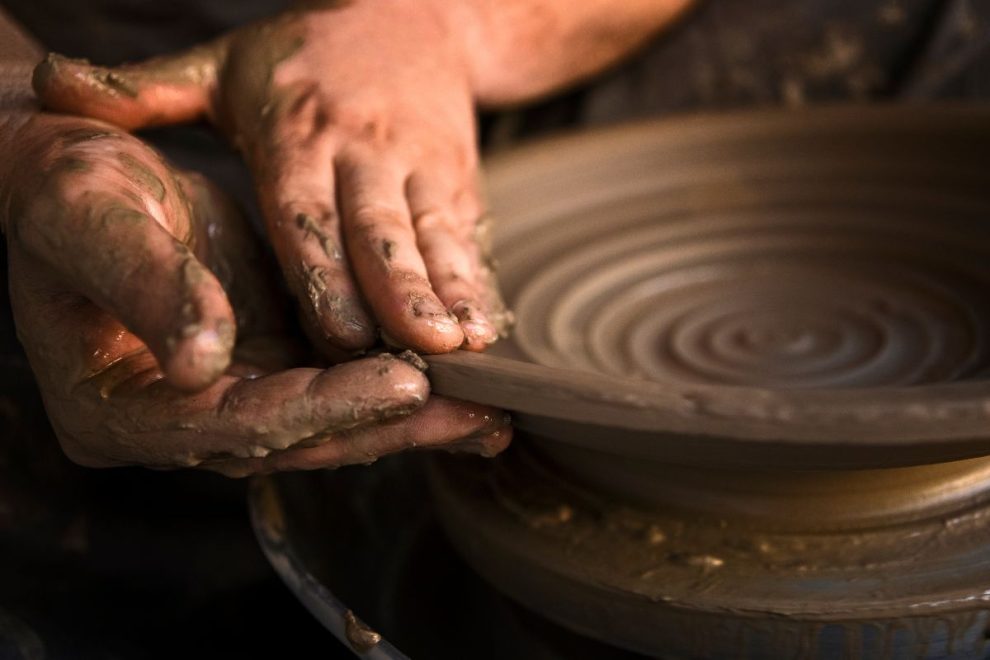
Materials and Tools Used by Minoan Potters
Minoan pottery production was an advanced skill. It used special materials and tools. The details are not all clear, but archaeological evidence helps us see how they worked. Most pottery production happened in small workshops. These were often close to places with good clay. For finer pottery, there were skilled artisans. They probably worked all day at the palaces.
One key innovation was the pottery wheel. It helped make pottery faster. It also made each piece look more alike. The Minoans built ceramic kilns with better controls for temperature. This helped them bake pottery better. The people did not use ceramic glazes on their pots. Instead, they used slips to make the bright designs.
Types of Clay and Additives
Minoan potters knew how to pick and get their materials ready. They chose different clay types based on what the pottery would be used for. For cooking pots, they mixed clay with bits of rock. This helped the pots stand up to changes in heat. For fine tableware, they used smooth clay that could be spun on a wheel. This let them make pots and dishes with very thin walls.
Instead of using ceramic glazes, they decorated the pottery with slip. Slip is a blend of fine clay and water. They made slips with lots of iron. This would make the pottery turn red or brown in a fire with lots of air. It would turn black in one with less air. They knew how to control the fire to get many colors without using regular ceramic glazes.
Additives had a big part in making their pots. Some key things they added are:
- Iron-red clay slip: Turns red or brown when fired.
- White slip: Used to paint light designs over a dark background.
- Rock fragments: Mixed in with clay for cooking pots to make them stronger.
The work that went into choosing the right materials was important for making the many kinds of pots and dishes seen in Bronze Age Minoan-type pottery.
Pottery Tools and Kiln Designs
The pottery wheel changed the way Minoans made pots in the Middle Minoan period. It let people shape pottery with more care and made the work go faster. The use of the pottery wheel started in the middle Minoan period. Soon, it was common in workshops at palaces. Hand-building did not stop, though. People still used that way to make very big pieces or when they wanted to shape something special.
Another big step was the ceramic kiln. Early Minoans first used pit-kilns. This was simple and didn’t give them much control. Later, they made cross-draft kilns. These kept the fire and pottery apart. This helped in getting higher, steady heat all around the pots and better control of the air inside. That kind of control helped make the colors that Minoan pottery is known for. Some old kilns have been dug up at settlement sites like Kommos. These finds show how kilns worked and were made. Experts such as Joseph W. Shaw say that kilns were key for making top-quality ceramics in the Middle Minoan period.
The changes in pottery production show the skills of the Minoan people. Minoan potters were both artists and careful workers. They always tried to make their craft better. What they learned stayed with ancient Greek pottery for a long time.
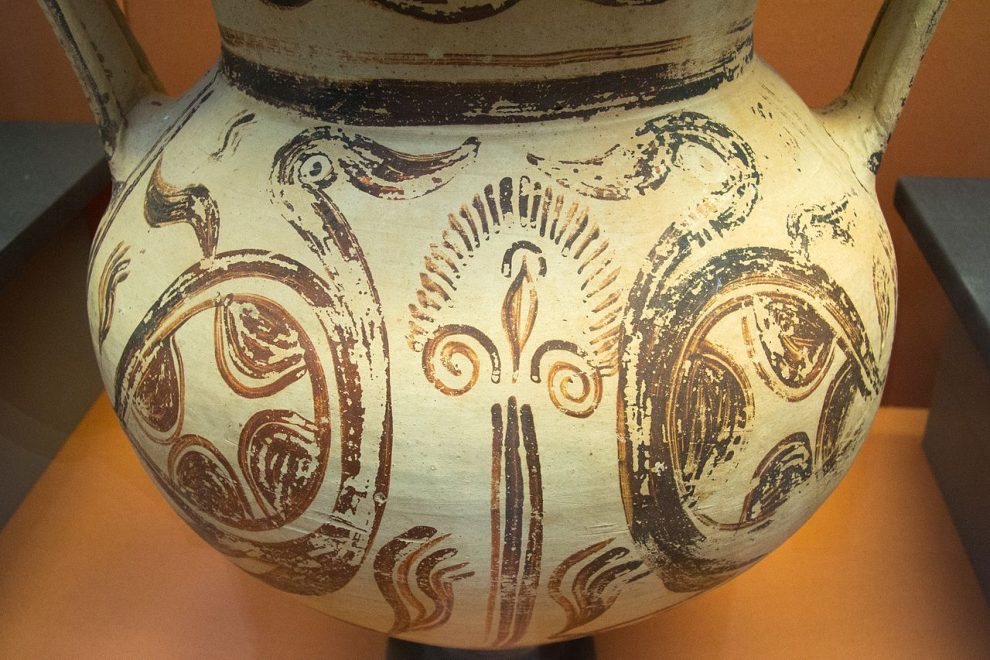
by: Zde
Symbols of Minoan Art Pottery
The decorations on Minoan pottery are much more than just nice designs. They are signs that can help us see what the Minoan people thought about their world. Minoan art will show up on these pots and jars with many pictures from their daily life and from what they believed. You will often find things like sea creatures, plants, and simple shapes.
Some symbols, such as double axes and the horns of consecration, were probably linked to how the people did their religious rituals. When we look at these images and see which ones show up again and again, we get to know what was important to the Minoans. They cared about the sea, and they had a big spiritual side, too. The next sections will take a closer look at Minoan art and these popular symbols like sea creatures and double axes.
Flora, Fauna, and Religious Iconography
The Minoans took a lot of ideas from the natural world around them, and you can see this in their pottery. The artists used many designs of plants and animals on vessels, showing the life they saw every day on the island of Crete. Being close to nature was a big part of Minoan art.
The marine style is a great example. It shows that the Minoans knew the sea so well. Along with plants and animals, some pottery also has religious motifs. These special symbols help us learn about what the Minoans believed, even though people still talk about what the symbols really mean.
Common natural and religious motifs found on Minoan pottery from the island of Crete include:
- Fauna: Octopuses, dolphins, fish, starfish, and birds.
- Flora: Lilies, papyrus flowers, crocuses, and seaweed.
- Religious Motifs: Bull’s heads, double axes, and sacral knots.
Human Activities and Daily Life Representations
While designs with shapes and pictures of nature were common, some Minoan pottery showed scenes with people and daily life. These pictures are rare, but they give us important details about Minoan culture. They help us see how people may have dressed, met with others, and took part in certain ceremonies.
One well-known example is the “Harvester Vase.” This is a stone jar that shows a lively group of men, who look like they are marching home after a harvest. The same types of scenes and people can be seen on other Minoan vases made of clay. Pictures like these let us know that pottery could be used to tell a story or help us remember important events for the community.
These sorts of images are usually seen at Minoan palaces and big settlement sites, where important people would organize rituals and do daily activities. The designs on a Minoan vase give us a quick look into daily life and what mattered most to people in that time.
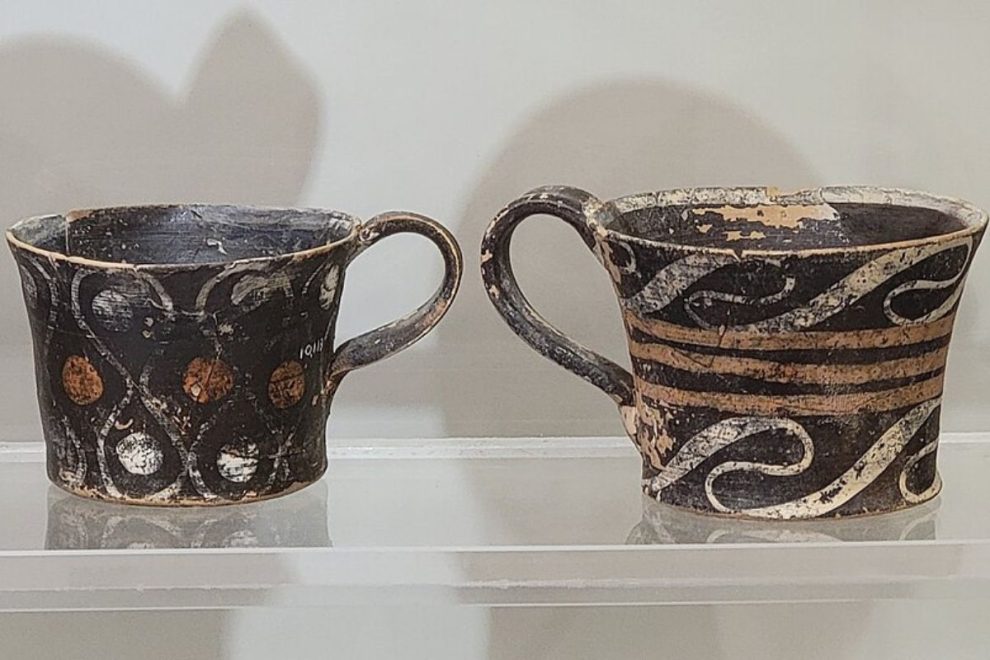
by: Викидим
Everyday Uses of Minoan Pottery
Minoan pottery was more than just something you put on a shelf to look at. It was an important part of everyday life in the Minoan period. There was a big range of shapes and sizes. This shows that pottery production was made to fit many uses. Some pieces were huge and meant for storage. Others were small, made for drinking. Every type had its own job. The many ways pottery was used tell us about how complex life was during the Minoan period.
Pottery made by the Minoans was high quality and found in many places. This shows there was a strong Minoan influence across the Aegean area. People used pottery at home, for trade, and in big ceremonies. Now, let’s take a closer look at what these items were for.
Pottery Roles at Home and In Trade
In the Minoan home, pottery was part of daily life. Large jars called pithoi were used a lot. They were kept in the magazines of Minoan palaces and held things like olive oil, wine, and grain. People used smaller jugs and cups to serve food and drink. For cooking, strong tripod pots were put on the fire to prepare meals. There was a lot of pottery production during this time, and this shows just how important pottery was for the household and for the way people lived.
When people traded goods, especially decorated ancient Greek pottery, Minoan artistic styles spread to new places, paving the way for traditions like black figure Greek pottery and Greek red and black pottery. This exchange was about more than just business. It also helped different cultures share ideas, so the Minoans had an impact that lasted a long time across the region.
Use of Ceramics During Rituals and Ceremonies
Ceramics were important in more than just everyday life for the Minoan people. In Minoan culture, they played a big role in rituals and religious events. Artisans made some vessels just for these occasions. They created rhyta, funnel-shaped cups, to pour liquid offerings during ceremonies. They also crafted rhyta to look like animals, such as bulls. This shows they had special meaning.
Minoan Pottery Beyond Crete
The story of Minoan pottery does not stop on the island of Crete. The strong Minoan influence moved across the Aegean, and their ceramics became a big part of this growth. During the late Minoan period, their pottery was sent to other places and people in these lands saw it as very valuable.
This Minoan influence was very powerful for the Mycenaean culture on the Greek mainland. As you will see, Mycenaean artists did not only bring in pottery from the Minoans. They also took the styles, forms, and ways of making pottery and made them their own. This sharing between the Minoans and Mycenaeans had a big effect and helped shape Greek art for a long time.
Impact on Mycenaean and Later Greek Pottery
The impact of Minoan influence on Mycenaean pottery is clear. When the Mycenaean Greeks moved into Knossos around 1450 BCE, they did not get rid of all Minoan traditions. Instead, the two came together to form a mix of both cultures. You can see this blend in the pottery from that time. The palace style has patterns like lilies and octopuses from Minoan art, mixed with a more rigid feel from the Mycenaeans.
This new way of making art was not only found in Crete. On mainland Greece, Mycenaean potters started to copy the shapes and decorations of the Minoan vase, eventually influencing Attic pottery and Corinthian pottery. They used forms like the stirrup jar and also copied marine and plant themes from the Minoans. But over time, the Mycenaean versions of these designs grew more simple and less realistic.
The bond between the two styles was important for the future. Taking Minoan ideas and using them in the Mycenaean world helped lay the base for later Greek art. The way Minoans liked natural shapes and smooth lines was picked up by the Mycenaeans, and this can be seen as part of what Greek art would come to be known for.
Modern Recognition and Museum Exhibits
Today, people see Minoan pottery as one of the big success stories of Bronze Age art. The skill and new ideas of Minoan makers stand out to those who study art, artists, and the public. These old ceramic pieces are seen as top displays in museums across the world. They help us get close to this interesting culture.
The top group of these works is at the Heraklion Archaeological Museum on Crete. Here you can see a wide, timed order of Minoan art. You find work from the Bronze Age here in a way you may not see anywhere else. The way Minoan potters made things even helps inspire new pieces, as artists today look to those forms and fun designs when making contemporary pottery, often compared with modern Greek pottery seen in workshops today.
If you want to see famous parts of Minoan pottery, here are the best places:
- The Heraklion Archaeological Museum, Crete: This holds the world’s biggest group of Minoan finds.
- The National Archaeological Museum, Athens: Here you will see important finds from the Greek mainland and islands.
- The Metropolitan Museum of Art, New York: This place features good samples of Minoan ware that ended up outside Greece.
Parting Thoughts
The story that Minoan pottery tells is full of the creativity and great skill of people from the Minoan culture. You can see everything from small handmade bowls to big, fancy palace ceramics. Over about two thousand years, these pieces show how their art changed with time. They also show how close these people were to the land around them, including plants from the island and animals from the Aegean Sea. When you look at this pottery, you do not just see old objects. You see into the lives, ideas, and the real art spirit of this special group from central Crete. Using ceramic kilns was a big part of pottery production, letting them bring their ideas to life. For anyone who wants to know more about Minoan culture, their art is a good place to start.

